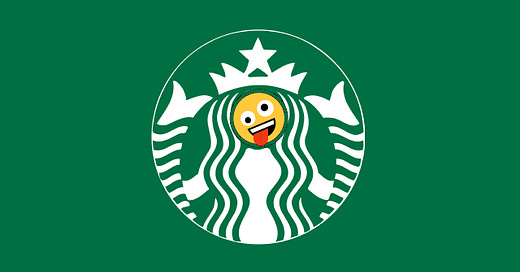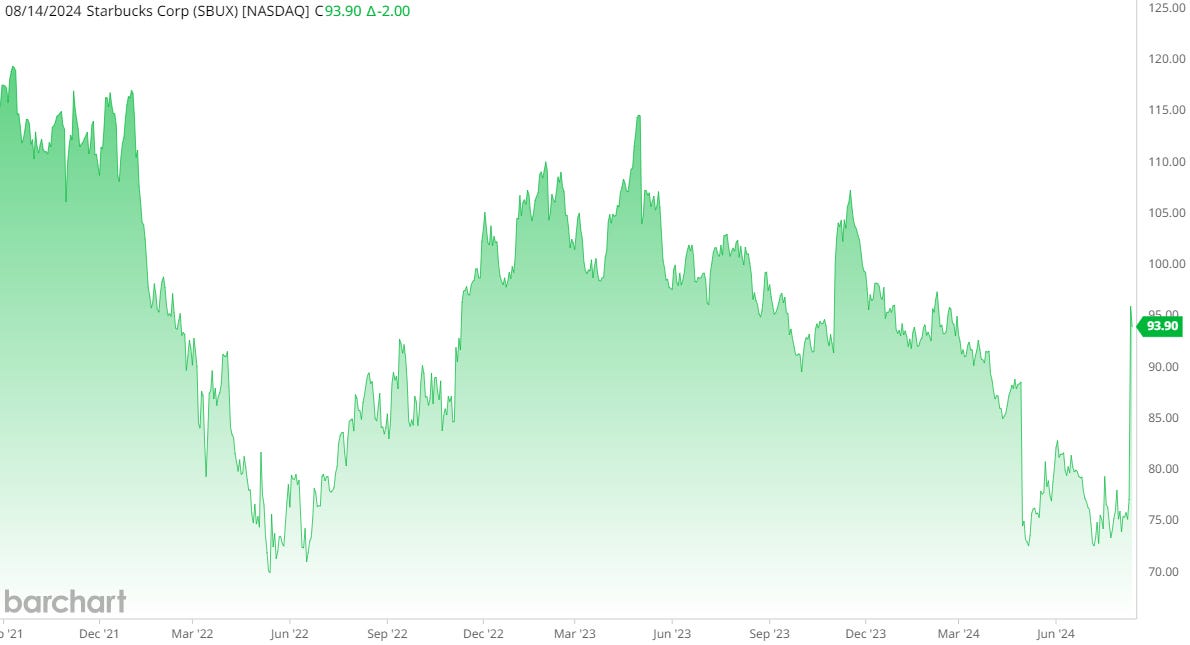The world’s largest coffeeshop chain received a jolt this week:
Laxman Narasimhan has stepped down as CEO and board director after roughly 16 months on the job. He was the first outside boss to lead the modern iteration of Starbucks and was the handpicked successor to Howard Schultz, the influential entrepreneur who helped build the company into a global coffee powerhouse.
Starbucks investors cheered the move, sending shares up 25% on Tuesday, the largest single-day percentage increase since the company’s market debut in 1992.
The news struck me because popular perceptions of Starbucks are so divergent. Most folks, I’ll unscientifically hypothesize, might shake out into one of these groups:
For a majority, it’s a morning commuting staple, borne out of habit and convenience, plus the lock-in effects of the loyalty program
To a mostly older crowd, it’s still the premium treat for which they overcame the sticker shock of “$4 lattes,” the cultural force that propelled Norah Jones’ career, and the ubiquitous presence that spawned (valid!) early-’00s jokes about “a Starbucks across from a Starbucks”
To serious coffee enthusiasts and millenial-ish professionals in big cities, local “third wave” options far surpass Starbucks at making a high-quality beverage, and likely do a better job at proving a trendy atmosphere and/or a sense of community
Personally, I fall into Group 3 (“that’s that me, espresso”). But, as a college student nearly 20 years ago, long before I’d ever heard of a “cortado,” I worked a part-time job as a Starbucks barista ☕...1
So, which group has the right idea today? All of them. Hence the identity crisis of Starbucks, forced to be too many things to too many people.
Maverick to mainstream
The huge popularity of Starbucks in the ‘90s and early ‘00s really was a boon to coffee drinkers, widely and forever elevating the quality of the drink and the role of the coffeeshop as a “third place” in America. But of course, that improvement didn’t stop with Starbucks. I cracked up, today reading this 2008 dispatch by Pulitzer Prize-winning food critic Jonathan Gold:
The new face of coffee is neither Juan Valdez nor a gum-snapping waitress named Madge, or even Starbucks’ Howard Schultz, but a postmodern barista like Tsuno, spiked hair and a gauzy shirt, stirring a siphon of Sumatran peaberry with the pouty insouciance of Jimmy Page executing a guitar solo, while awestruck customers study every flick of his long fingers.
Beyond laying the groundwork for the (long outdated) hipster barista stereotype at indie cafes, Starbucks’ success inspired the likes of Dunkin’ and McDonald’s to step up their own coffee games. While these competitors cater to a less picky drinker than Starbucks, they are generally more affordable, already have dedicated fans of their breakfast food, and (with no complicated drink orders on offer) can typically win out on speed of order fulfilment.
Additionally, with Starbucks prioritizing mobile orders, their U.S. cafes have lost their “third place” (and remote work) luster.2 In my post-pandemic visits, what’s stood out are:
Far fewer seats and tables
Harried baristas filling out a backlog of orders, placed in an app, from customers with whom they never interact.
In short, if you’re a McMuffin fan, you don’t need Starbucks anymore. If you’re cost conscious, you’re making it at home or getting a Dunk iced coffee.3 And if you don’t want an espresso drink that tastes horrible (how is Starbucks still so bad at this?!), you’ve got upscale options with national reach (e.g. Stumptown, Blue Bottle, La Colombe), region-specific (e.g. SF’s Sightglass, Equator), or umpteen standalone cafes.
Only one man can?
Long-time Starbucks head Howard Schultz initially stepped down as CEO in 2000, but has twice returned to the gig (2008-2017, 2022-2023). Absent a formal role, he continues to publicly subtweet his old company and coach from the sidelines.
Despite his undeniable successes at the helm, Schultz has been criticized for his strident anti-union position, for setting the aggressive growth plan that Starbucks is now failing to deliver on, and for turning on Narasimhan soon after wooing him.
Before things went south, at least, I appreciated that Schultz had Narasimhan get grounded in the realities of his new job by spending six months as a barista. Makes sense, given this 2022 anecdote about Schultz’s frustration with “out of touch” execs at the company:
“Is there anyone in this room who can go with me to an espresso machine and make a latte? I don’t think we can fix the systemic problem with the level of lofty knowledge that exists in this room.”
Mermaid of sterner stuff
Dramatic CEO changes and the accompanying news headlines can create a misperception of a business that is widely failing, as opposed to one making over $1 billion in net income each quarter. Last 3Qs revenue is actually up slightly versus the same period a year prior. And I remain flabbergasted that Starbucks customers keep a combined ~$3 billion locked in their Rewards Cards!
If Starbucks keeps trying to please everyone, it’s possible they’ve reached their growth ceiling. But I think it’s more likely that over the next several years they lean into their post-pandemic world of mobile orders, savvy discounting and promotional efforts, and store efficiencies. They’ll fully cede the expensive, niche end of the market, but in retreating from having comfy cafes at which to sit and linger, they’ll have lower costs, and be able to operate and run in even smaller store footprints than currently.4
China remains a question mark due to the rise of Luckin (and their shady accounting!), but there are other international markets still ripe for expansion where the brand name carries value and it will be easier to occupy the middle and high end of the market. (I visited a few Starbucks in India last month; the experience there is much nicer—or, how it used to be in the US. Local “third wave” competitors like Blue Tokai are many years from being a threat.)
It’ll be up to Starbucks’ new potential savior. Gushed Mellody Hobson, board chair (a title she will hand over to the new guy): “We had the opportunity to get Brian Niccol. In the industry, he’s probably the most successful CEO right now.” 🤩
For what it’s worth, Niccol’s resume is how Teenage Jay would’ve plotted a career prioritizing employee free food or drinks: CEO of Taco Bell, CEO of Chipotle, and shortly, CEO of Starbucks!
Officially, I worked at a Seattle’s Best cafe; Starbucks owned the chain, which at the time it operated as a more affordable sibling brand. I like to think I could still pull a decent shot on a La Marzocco!
By the end of 2023, 31% of Starbucks US transactions were in-app, and that share is expected to continue growing steadily.
Might as well plug my preferred intersection of “cost conscious” and “high quality coffee”: for the past decade, my daily coffee choice has been to make cold brew batches at home, with beans from local specialty cafes. This $35 OXO compact drip tower will last a lifetime!
I’m confident there are never going to be more than a token number of their fancy (and genuinely cool) “Reserve Roastery” concept cafes.






Starbucks sells its brand more than it sells good coffee. Walking around with a Starbucks logo is a status symbol.
If they're no longer a place to sit and drink coffee, maybe they should start making healthy to-go options like protein smoothies and bowls?